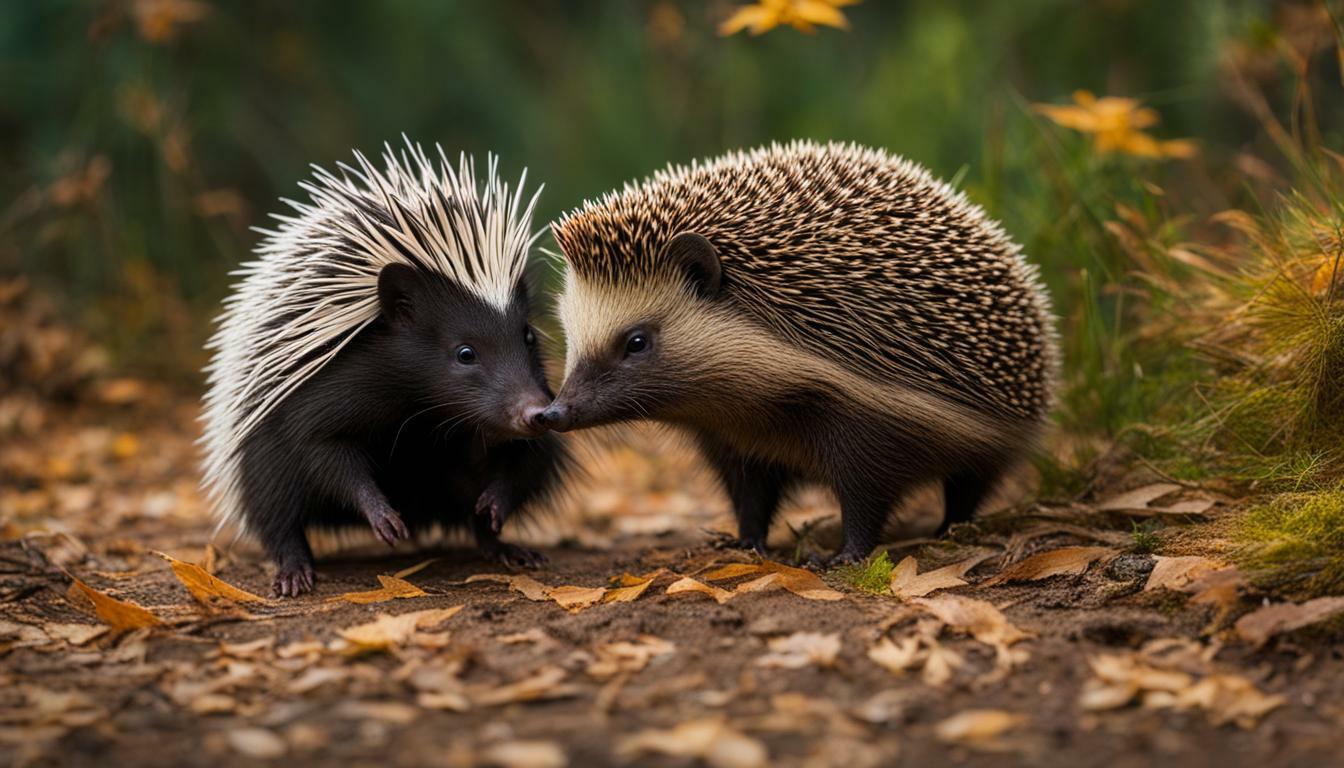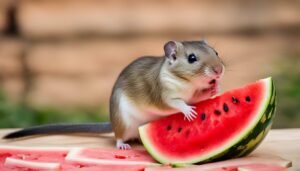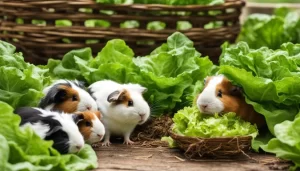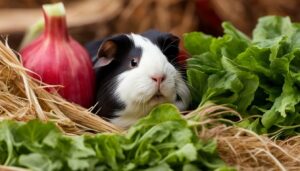Porcupines and hedgehogs may share some similarities, but they also have distinct characteristics that set them apart. While both animals are known for their prickly quills, porcupines are larger, measuring an average length of 25-36 inches compared to hedgehogs, which typically range from 4-12 inches. Additionally, porcupines possess around 30,000 quills, whereas hedgehogs have approximately 5,000. Porcupine quills can grow up to 2-3 inches in length, while hedgehog quills are usually around 1 inch long.
Another notable difference between the two species lies in their diets. Hedgehogs are insectivores, subsisting primarily on a diet of insects and invertebrates. On the other hand, porcupines are herbivores, feeding on plant materials such as bark, leaves, and twigs.
When it comes to defense mechanisms, hedgehogs tend to curl into a protective ball when threatened, effectively shielding their vulnerable underbellies with their quills. Porcupines, however, rely on a different approach. They push their quills towards predators, which can become painfully embedded in the skin. Additionally, porcupines may also wave their tail to increase the chances of getting their quills lodged into an attacker.
As for lifespan, hedgehogs typically live for 3-8 years, while porcupines have a much longer life expectancy, with some individuals reaching up to 27 years. Geographic distribution is another distinguishing factor, with hedgehogs found in Europe and Africa, while porcupines are native to North America.
Key Takeaways:
- Porcupines are larger than hedgehogs, measuring 25-36 inches in length compared to 4-12 inches for hedgehogs.
- Porcupines have around 30,000 quills, while hedgehogs possess approximately 5,000.
- Hedgehogs are insectivores, while porcupines are herbivores.
- Hedgehogs curl into a ball as a defensive mechanism, whereas porcupines push their quills at predators.
- Hedgehogs have a lifespan of 3-8 years, while porcupines can live up to 27 years.
- Hedgehogs are found in Europe and Africa, while porcupines are native to North America.
Size and Appearance
Porcupines are generally larger than hedgehogs, with an average length of 25-36 inches compared to the hedgehog’s 4-12 inches. These prickly creatures have distinct physical characteristics that set them apart. Porcupines have a robust body covered in sharp quills that can grow up to 2-3 inches in length. Their quills are thick and densely packed, giving them a formidable appearance. In contrast, hedgehogs have shorter quills, measuring around 1 inch in length. Their small size and compact bodies make them more agile and suitable for maneuvering through dense vegetation.
When it comes to body shape, porcupines have a stocky build with short legs and a round head. Their feet are equipped with sharp claws, which aid in climbing trees and foraging for food. Hedgehogs, on the other hand, have a more elongated body shape with stout legs and a pointed snout. Their feet are adapted for digging and burrowing.
Overall, porcupines and hedgehogs possess distinct sizes and appearances that differentiate them from one another. While porcupines boast a larger size and more formidable quills, hedgehogs are smaller and more agile, with shorter quills suited for their unique habitat and lifestyle.
| Porcupines | Hedgehogs |
|---|---|
| Average length: 25-36 inches | Average length: 4-12 inches |
| Quill length: 2-3 inches | Quill length: 1 inch |
| Body shape: Stocky | Body shape: Elongated |
| Feet: Equipped with sharp claws for climbing | Feet: Adapted for digging and burrowing |
Quill Comparison
While both porcupines and hedgehogs possess sharp quills, there are notable differences in the number and size of their quills. Porcupines have an impressive arsenal of around 30,000 quills, which are firmly embedded in their thick, spiky fur. These quills can grow to be 2-3 inches long, providing excellent defense against predators. In contrast, hedgehogs have a more modest collection of approximately 5,000 quills that cover their back, sides, and head. Their quills are shorter, measuring about 1 inch in length.
The quill colors also differ between the two species. Porcupine quills are typically a mix of black and white, giving them a striking appearance. Hedgehog quills, on the other hand, are primarily brown or tan, providing them with camouflage in their natural habitats. Both porcupines and hedgehogs rely on their quills as a means of defense, but their variations in number, size, and color make them easily distinguishable.
| Porcupine | Hedgehog |
|---|---|
| Number of Quills | Average of 30,000 |
| Quill Length | 2-3 inches |
| Quill Color | Black and white |
In summary, porcupines possess a greater quantity of longer quills compared to hedgehogs. Their quills are black and white, while hedgehog quills tend to be shorter, primarily brown or tan in color. This distinctive variation in quill characteristics contributes to the overall uniqueness and individuality of these two fascinating creatures.
Diet and Feeding Habits
Hedgehogs are insectivores, primarily feeding on insects and small invertebrates, whereas porcupines are herbivores, consuming vegetation and plant matter. This stark difference in diet is reflected in their physical characteristics and feeding behaviors.
Porcupines have specialized teeth adapted for gnawing and grinding tough plant material. Their diet consists mainly of leaves, bark, twigs, and roots. Their strong jaw muscles and sharp incisors help them strip and chew vegetation effectively. Porcupines are known to be capable climbers, using their sharp claws and prehensile tail to maneuver through trees and reach their preferred food sources.
In contrast, hedgehogs have teeth designed for capturing and crushing insects. Their diet includes beetles, worms, snails, and other small invertebrates found in their natural habitat. Hedgehogs use their keen sense of smell to locate prey and their long tongue to extract food from crevices. They may also supplement their diet with fruits, berries, and even eggs when available.
The table below summarizes the main differences in diet and feeding habits between porcupines and hedgehogs:
| Characteristic | Porcupines | Hedgehogs |
|---|---|---|
| Primary Diet | Vegetation and plant matter | Insects and small invertebrates |
| Jaw Adaptations | Strong muscles, sharp incisors | Crushing teeth for capturing insects |
| Feeding Behavior | Strip, chew, and gnaw plant material | Locate and consume small prey |
Defense Mechanisms
When threatened, hedgehogs instinctively curl into a protective ball, whereas porcupines rely on their quills, pushing them towards predators and using their tail to secure the quills. This is a striking difference in defense mechanisms between these two prickly creatures.
Hedgehogs, with their compact bodies and spiky armor, have the remarkable ability to roll up into a tight ball, exposing only their sharp quills to potential threats. This defensive posture, known as “balling up,” provides hedgehogs with a formidable shield against predators. Their hinged spines interlock, making it challenging for attackers to reach their soft underbellies. This adaptation is incredibly effective in warding off potential harm.
On the other hand, porcupines have a different strategy for self-defense. Rather than relying solely on rolling into a ball, they have an impressive array of sharp quills to deter predators. When threatened, a porcupine will face the predator, rattle its quills, and use its muscular tail to propel the quills towards the attacker. The barbed quills easily stick into the predator’s flesh, causing pain and discomfort. Additionally, porcupines have specialized quills on their tails that are longer and more rigid, serving as an extra line of defense.
| Hedgehog | Porcupine | |
|---|---|---|
| Lifespan | 3-8 years | Up to 27 years |
| Native Distribution | Europe and Africa | North America |
These distinct defense mechanisms showcase the evolutionary adaptations of hedgehogs and porcupines. While hedgehogs rely on the ability to curl up into a protective ball, porcupines have developed quills as their primary mode of defense. These remarkable adaptations have allowed these creatures to survive and thrive in their respective environments.
Lifespan
Hedgehogs typically have a lifespan of 3-8 years, while porcupines can live up to an impressive 27 years. This significant difference in longevity can be attributed to several factors, including their respective habitats and physiological differences.
Hedgehogs, with their smaller size and insectivorous diet, tend to have shorter lifespans. They are known for their active and secretive lifestyle, often found foraging for insects and other small prey at night. Unfortunately, many hedgehogs fall victim to predators, road accidents, and harsh environmental conditions, which can contribute to their shorter lifespan.
Porcupines, on the other hand, have a longer lifespan. These herbivorous animals are well-adapted to their North American habitats and possess a more robust defense mechanism with their sharp quills. Their larger size and slower metabolism may also aid in their ability to survive for extended periods. With fewer natural predators and a more specialized diet, porcupines can live up to almost three decades.
Lifespan Comparison: Hedgehog vs. Porcupine
| Species | Average Lifespan |
|---|---|
| Hedgehog | 3-8 years |
| Porcupine | Up to 27 years |
In conclusion, while hedgehogs may be cherished for their cute and prickly appearance, their lifespan is relatively short compared to porcupines. Understanding the differences in lifespan between these two unique creatures sheds light on their distinct behaviors, adaptations, and their overall place in the animal kingdom.
Geographic Distribution
Hedgehogs can be found in Europe and Africa, while porcupines are native to North America. These prickly creatures have adapted to diverse environments across these regions, each with its own unique habitat requirements.
In Europe, hedgehogs are widely distributed, with populations spanning from the British Isles to Scandinavia, and down to the Mediterranean countries. They inhabit a variety of habitats, including woodlands, grasslands, and even urban areas. Hedgehogs are known for their ability to survive in close proximity to human settlements, often finding shelter in gardens and parks.
Porcupines, on the other hand, are primarily found in North America, ranging from Canada to Mexico. They inhabit a wide range of ecosystems, from forests and deserts to grasslands and mountains. Porcupines are well-adapted to their environments, with their quills providing both protection and insulation in colder climates.
Hedgehog Distribution in Europe
| Country | Regions |
|---|---|
| United Kingdom | England, Scotland, Wales, Northern Ireland |
| France | Alsace, Brittany, Normandy, Provence, etc. |
| Germany | Bavaria, Brandenburg, Rhineland-Palatinate, etc. |
| Spain | Andalusia, Catalonia, Galicia, Valencia, etc. |
Porcupines, with their distinct appearance and quills, are a familiar sight in the North American wilderness. They can be found in various regions across the continent:
- Canada: Porcupines inhabit the boreal forests of Canada, spanning from British Columbia in the west to Newfoundland and Labrador in the east.
- United States: They are found in many states, including Alaska, Maine, Michigan, and Colorado, adapting to different habitats ranging from forests and grasslands to deserts and mountains.
- Mexico: In Mexico, porcupines are found in the northern regions, such as Sonora and Chihuahua, as well as in the central areas of the country.
While hedgehogs and porcupines may share some similarities, their geographic distribution clearly sets them apart, with hedgehogs thriving in Europe and Africa, and porcupines calling North America their home.
Behavior and Lifestyle
Hedgehogs are primarily nocturnal creatures, while porcupines are more active during the day, demonstrating different behavioral patterns. Hedgehogs are solitary animals, often found foraging for food and exploring their surroundings in the dark. They rely heavily on their acute sense of smell and hearing to navigate and locate prey, primarily consisting of insects, worms, and small invertebrates.
Porcupines, on the other hand, are known for their slower and deliberate movements. They spend a considerable amount of time on the ground, foraging for plant matter such as leaves, bark, and twigs. Porcupines are often found in trees, using their strong claws and prehensile tail to maneuver through branches and foliage in search of food.
In terms of social behavior, hedgehogs are generally more solitary and territorial, preferring to have their own space. They build nests made of leaves and other natural materials, where they retreat during the day and hibernate during colder months. Porcupines, although also having individual territories, are known to exhibit more sociable behavior. They have been observed forming small family groups and sharing dens during harsh weather conditions.
| Behavior and Lifestyle | Hedgehogs | Porcupines |
|---|---|---|
| Nocturnal or Diurnal | Nocturnal | Diurnal |
| Main Food Sources | Insects, worms, small invertebrates | Plant matter (leaves, bark, twigs) |
| Social Behavior | Solitary, territorial | Sociable, small family groups |
Reproduction
Porcupines and hedgehogs have distinct reproductive strategies, with variations in mating behaviors and gestation periods. While porcupines are polygamous animals, hedgehogs are mostly monogamous. Male porcupines compete for the attention of female porcupines during the breeding season, engaging in vocalizations and physical displays to establish dominance.
Once a male porcupine successfully mates with a female, the gestation period lasts around 112 days. Female porcupines give birth to a single offspring, called a porcupette, which is born with its quills soft and flexible, hardening within a few hours. The porcupette is entirely dependent on its mother for nourishment and protection, although it begins developing its own quills within a few weeks.
Hedgehogs, on the other hand, engage in courtship rituals that involve scent marking and vocalizations to attract a suitable mate. After successful mating, the gestation period for hedgehogs lasts approximately 32-40 days. Female hedgehogs give birth to a litter of hoglets, usually numbering 4-5. These hoglets are born blind and hairless, relying on their mother for warmth and nourishment. As they grow, their spines gradually emerge and harden.
Here is a table summarizing the differences in reproduction between porcupines and hedgehogs:
| Characteristic | Porcupines | Hedgehogs |
|---|---|---|
| Mating Behavior | Polygamous | Monogamous |
| Gestation Period | Approximately 112 days | Approximately 32-40 days |
| Offspring | Single porcupette | Litter of hoglets (4-5) |
Overall, the reproduction processes of porcupines and hedgehogs vary significantly, reflecting their distinct biological and behavioral characteristics.
Environmental Adaptations
Porcupines and hedgehogs have evolved specific characteristics to thrive in their environments, displaying different adaptations. These adaptations allow them to survive and navigate their natural habitats effectively.
One of the key distinguishing features of porcupines is their quills. Porcupines have an impressive defense mechanism, with approximately 30,000 quills covering their bodies. These quills are designed to deter predators and are covered in tiny barbs that make them difficult to remove once embedded in an attacker. Additionally, when threatened, porcupines can raise and rattle their quills and use their muscular tail to strike predators, effectively deterring them from approaching.
Hedgehogs, on the other hand, have their own unique adaptations. Their quills are shorter and sturdier, measuring about 1 inch in length. Hedgehogs have the remarkable ability to roll into a tight ball, effectively protecting their vulnerable underbelly. This behavior exposes their sharp quills outward, creating a shield against potential threats. Hedgehogs also possess a keen sense of hearing and smell, which allows them to detect approaching predators and quickly roll into protective mode.
| Porcupines | Hedgehogs | |
|---|---|---|
| Size | Larger (25-36 inches) | Smaller (4-12 inches) |
| Quills | About 30,000 | About 5,000 |
| Quill Length | 2-3 inches | 1 inch |
| Diet | Herbivorous | Insectivorous |
| Lifespan | Up to 27 years | 3-8 years |
| Distribution | Native to North America | Found in Europe and Africa |
In conclusion, while both porcupines and hedgehogs possess quills for defense, they exhibit distinct adaptations that suit their respective environments. Porcupines’ larger size, greater quill quantity, and unique defense mechanisms make them formidable herbivores in North America. Hedgehogs, on the other hand, have smaller bodies, shorter quills, and the ability to curl into a protective ball, enabling them to navigate and survive in regions of Europe and Africa.
Conclusion
In conclusion, while porcupines and hedgehogs may share some prickly similarities, their contrasting sizes, quill characteristics, diets, behaviors, and habitats set them apart as unique and fascinating creatures.
Porcupines are larger than hedgehogs, with an average length of 25-36 inches compared to 4-12 inches for hedgehogs. They also have a greater number of quills, boasting around 30,000 compared to the hedgehog’s 5,000. The length of porcupine quills can grow up to 2-3 inches, while hedgehog quills are about 1 inch long.
When it comes to diet, hedgehogs are insectivores, relying on a diet primarily composed of insects. On the other hand, porcupines are herbivores, consuming a variety of plants, leaves, bark, and roots.
In terms of defense mechanisms, hedgehogs curl into a protective ball when threatened, utilizing their quills as a shield. Porcupines, however, use a different tactic, pushing their quills at predators and may even wave their tail to stick them.
The lifespan of hedgehogs ranges from 3 to 8 years, while porcupines have a significantly longer lifespan, living up to 27 years under favorable conditions.
Hedgehogs can be found in Europe and Africa, while porcupines are native to North America. These different habitats contribute to variations in their behavior and lifestyle patterns.
Overall, the contrasting characteristics, habits, and environments of porcupines and hedgehogs make them fascinating creatures to study and appreciate.
FAQ
What is the difference between a porcupine and a hedgehog?
Porcupines and hedgehogs are both prickly animals with sharp quills, but they have several differences. Porcupines are larger than hedgehogs, with an average length of 25-36 inches compared to 4-12 inches for hedgehogs. Porcupines also have more quills, with around 30,000 compared to the hedgehog’s 5,000. Hedgehog quills are about 1 inch long, while porcupine quills can grow to 2-3 inches. Hedgehogs are insectivores, while porcupines are herbivores. Hedgehogs curl into a ball when threatened, while porcupines push their quills at predators and may wave their tail to stick them. Hedgehogs have a lifespan of 3-8 years, while porcupines can live up to 27 years. Hedgehogs are found in Europe and Africa, while porcupines are native to North America.
What is the size and appearance difference between porcupines and hedgehogs?
Porcupines are larger than hedgehogs, with an average length of 25-36 inches compared to 4-12 inches for hedgehogs.
How do the quills of porcupines and hedgehogs differ?
Porcupines have around 30,000 quills, while hedgehogs have around 5,000. Hedgehog quills are about 1 inch long, while porcupine quills can grow to 2-3 inches.
What are the dietary differences between porcupines and hedgehogs?
Hedgehogs are insectivores, while porcupines are herbivores.
How do porcupines and hedgehogs defend themselves?
Hedgehogs curl into a ball when threatened, while porcupines push their quills at predators and may wave their tail to stick them.
What is the difference in lifespan between porcupines and hedgehogs?
Hedgehogs have a lifespan of 3-8 years, while porcupines can live up to 27 years.
Where are hedgehogs and porcupines found geographically?
Hedgehogs are found in Europe and Africa, while porcupines are native to North America.
How do the behavior and lifestyle of porcupines and hedgehogs differ?
Porcupines and hedgehogs exhibit contrasting behavior and lifestyle patterns.
What are the differences in reproduction between porcupines and hedgehogs?
There are differences in reproduction between porcupines and hedgehogs.
How do porcupines and hedgehogs adapt to their environments?
Porcupines and hedgehogs have unique adaptations to their respective habitats.




